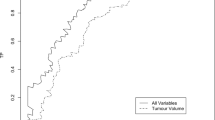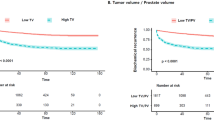Abstract
Previous studies have suggested that maximum tumor diameter (MTD) is a predictor of PSA recurrence or biochemical recurrence (BCR) in prostate cancer after radical prostatectomy (RP). The significance of MTD in BCR prediction was evaluated using RP specimens of 364 patients with a BCR of 18% (n=66) during a mean follow-up of 37.4 months (range: 10–109 months). MTD was defined as the largest diameter of the largest tumor, and its median MTD was 15 mm (range: 0.9–50 mm). MTD was significantly associated with pre-operative PSA levels, pathological T stage, Gleason's score and positive surgical margin. In a univariate analysis, pathological T stage, Gleason's score, positive surgical margin and MTD were associated significantly with the risk of BCR. Patients with >20 mm MTD had a significantly higher risk of BCR than did those with ⩽20 mm MTD (P<0.001). Cox multivariate models indicated that pathological stage, Gleason's score, positive surgical margin and MTD were independent prognostic factors for BCR. MTD would be a useful tool for predicting BCR, as calculation of MTD is a simple and reliable measure.
This is a preview of subscription content, access via your institution
Access options
Subscribe to this journal
Receive 4 print issues and online access
$259.00 per year
only $64.75 per issue
Buy this article
- Purchase on Springer Link
- Instant access to full article PDF
Prices may be subject to local taxes which are calculated during checkout

Similar content being viewed by others
References
Han M, Partin AW, Pound CR, Epstein JI, Walsh PC . Long-term biochemical disease-free and cancer-specific survival following anatomic radical retropubic prostatectomy. The 15-year Johns Hopkins experience. Urol Clin North Am 2001; 28: 555–565.
Ward JF, Moul JW . Rising prostate-specific antigen after primary prostate cancer therapy. Nat Clin Pract Urol 2005; 2: 174–182.
Kupelian P, Katcher J, Levin H, Zippe C, Klein E . Correlation of clinical and pathologic factors with rising prostate-specific antigen profiles after radical prostatectomy alone for clinically localized prostate cancer. Urology 1996; 48: 249–260.
Hernandez DJ, Nielsen ME, Han M, Trock BJ, Partin AW, Walsh PC et al. Natural history of pathologically organ-confined (pT2), Gleason score 6 or less, prostate cancer after radical prostatectomy. Urology 2008; 72: 172–176.
Carvalhal GF, Humphrey PA, Thorson P, Yan Y, Ramos CG, Catalona WJ . Visual estimate of the percentage of carcinoma is an independent predictor of prostate carcinoma recurrence after radical prostatectomy. Cancer 2000; 89: 1308–1314.
Stamey TA, McNeal JE, Yemoto CM, Sigal BM, Johnstone IM . Biological determinants of cancer progression in men with prostate cancer. JAMA 1999; 281: 1395–1400.
Mizuno R, Nakashima J, Mukai M, Ookita H, Nakagawa K, Oya M et al. Maximum tumor diameter is a simple and valuable index associated with the local extent of disease in clinically localized prostate cancer. Int J Urol 2006; 13: 951–955.
Mizuno R, Nakashima J, Mukai M, Okita H, Kosugi M, Kikuchi E et al. Tumour length of the largest focus predicts prostate-specific antigen-based recurrence after radical prostatectomy in clinically localized prostate cancer. BJU Int 2009; 104: 1215–1218.
Nelson BA, Shappell SB, Chang SS, Wells N, Farnham SB, Smith Jr JA et al. Tumour volume is an independent predictor of prostate-specific antigen recurrence in patients undergoing radical prostatectomy for clinically localized prostate cancer. BJU Int 2006; 97: 1169–1172.
Epstein JI, Carmichael M, Partin AW, Walsh PC . Is tumor volume an independent predictor of progression following radical prostatectomy? A multivariate analysis of 185 clinical stage B adenocarcinomas of the prostate with 5 years of follow-up. J Urol 1993; 149: 1478–1481.
Salomon L, Levrel O, Anastasiadis AG, Irani J, De La Taille A, Saint F et al. Prognostic significance of tumor volume after radical prostatectomy: a multivariate analysis of pathological prognostic factors. Eur Urol 2003; 43: 39–44.
Kikuchi E, Scardino PT, Wheeler TM, Slawin KM, Ohori M . Is tumor volume an independent prognostic factor in clinically localized prostate cancer? J Urol 2004; 172: 508–511.
Ohori M, Kattan M, Scardino PT, Wheeler TM . Radical prostatectomy for carcinoma of the prostate. Mod Pathol 2004; 17: 349–359.
Mouraviev V, Mayes JM, Polascik TJ . Pathologic basis of focal therapy for early-stage prostate cancer. Nat Rev Urol 2009; 6: 205–215.
Noguchi M, Stamey TA, McNeal JE, Nolley R . Prognostic factors for multifocal prostate cancer in radical prostatectomy specimens: lack of significance of secondary cancers. J Urol 2003; 170: 459–463.
Wise AM, Stamey TA, McNeal JE, Clayton JL . Morphologic and clinical significance of multifocal prostate cancers in radical prostatectomy specimens. Urology 2002; 60: 264–269.
Renshaw AA, Richie JP, Loughlin KR, Jiroutek M, Chung A, D’Amico AV . Maximum diameter of prostatic carcinoma is a simple, inexpensive, and independent predictor of prostate-specific antigen failure in radical prostatectomy specimens. Validation in a cohort of 434 patients. Am J Clin Pathol 1999; 111: 641–644.
Renshaw AA, Richie JP, Loughlin KR, Jiroutek M, Chung A, D’Amico AV . The greatest dimension of prostate carcinoma is a simple, inexpensive predictor of prostate specific antigen failure in radical prostatectomy specimens. Cancer 1998; 83: 748–752.
Eichelberger LE, Koch MO, Daggy JK, Ulbright TM, Eble JN, Cheng L . Predicting tumor volume in radical prostatectomy specimens from patients with prostate cancer. Am J Clin Pathol 2003; 120: 386–391.
Eichelberger LE, Koch MO, Eble JN, Ulbright TM, Juliar BE, Cheng L . Maximum tumor diameter is an independent predictor of prostate-specific antigen recurrence in prostate cancer. Mod Pathol 2005; 18: 886–890.
van Oort IM, Witjes JA, Kok DE, Kiemeney LA, Hulsbergen-vandeKaa CA . Maximum tumor diameter is not an independent prognostic factor in high-risk localized prostate cancer. World J Urol 2008; 26: 237–241.
Dvorak T, Chen MH, Renshaw AA, Loffredo M, Richie JP, D’Amico AV . Maximal tumor diameter and the risk of PSA failure in men with specimen-confined prostate cancer. Urology 2005; 66: 1024–1028.
Author information
Authors and Affiliations
Corresponding author
Ethics declarations
Competing interests
The authors declare no conflict of interest.
Rights and permissions
About this article
Cite this article
Fukuhara, H., Kume, H., Suzuki, M. et al. Maximum tumor diameter: a simple independent predictor for biochemical recurrence after radical prostatectomy. Prostate Cancer Prostatic Dis 13, 244–247 (2010). https://doi.org/10.1038/pcan.2010.17
Received:
Revised:
Accepted:
Published:
Issue Date:
DOI: https://doi.org/10.1038/pcan.2010.17
Keywords
This article is cited by
-
Development of risk-score model in patients with negative surgical margin after robot-assisted radical prostatectomy
Scientific Reports (2024)
-
Positive surgical margin is associated with biochemical recurrence risk following radical prostatectomy: a meta-analysis from high-quality retrospective cohort studies
World Journal of Surgical Oncology (2018)
-
The association of tumor volume with mortality following radical prostatectomy
Prostate Cancer and Prostatic Diseases (2014)
-
Maximum tumor diameter adjusted to the risk profile predicts biochemical recurrence after radical prostatectomy
Virchows Archiv (2014)



